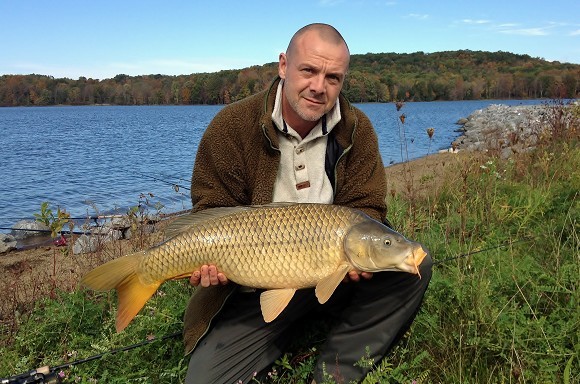
Carp Letter from America - March
Our bloggers in America, Simon and Andy, give us their first update on fishing for carp the other side of the pond...
It’s still cold here. The snow has yet to melt in places and some of our local waters continue to be ice-bound. While many in temperate England may brave the cooler weather to fish for carp, here such foolhardiness is called ice fishing. Ice fishing involves drilling equipment, ice ladles, wearing triple-layered down y-fronts under Antarctic category survival suits and drinking considerable quantities of plum brandy. Much as it is our desire to bring you stories about carp fishing from our little corner of the U. S of A as early in the season as possible, dying of hypothermia for the cause is certainly not one of them.
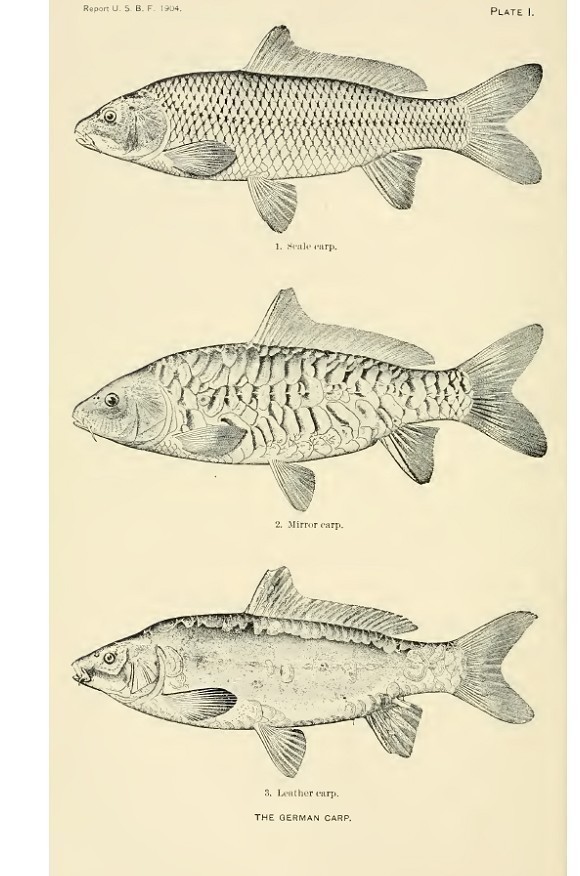
Early representations of carp in the US Fisheries Bulletin from 1904.
So no fishing yet; instead some introductions and a bit of scene setting. We have been in Pennsylvania for about seven years now, both of us coming across to the States from Scotland when our work moved here. In Scotland, Simon enjoyed the fly-fishing and Andy enjoyed the severe delights of northern ‘pubs’. While this doesn’t sound promising from a carp fishing point of view we are in fact life-long fishermen. Andy grew up in north London fishing for whatever he could get, defecting for a while to the match fishing scene of the 1980s before returning to the carp fishing in more recent years. He is a confirmed tinker and obsesses endlessly about rigs and presentation. Simon grew up in Kent and has always fished for carp. And tench and rudd and chub and perch and … well you get the picture. He grew up more in the tradition of B. B. and Chris Yates but is now being shown the ropes of modern carp fishing by Andy. Who is, in turn, getting refreshers from his brother remote in England, the internet and the arcane intricacies of Carpology’s excellent Rig-Guide. So, we are far from ‘professional’. Gifted amateurs might be one way of describing us as long as you realize that the ‘gifted’ bit is a lie. Nevertheless, we are here, in the States, with carp rods and an eclectic grasp of carp fishing both ancient and modern. We are also surrounded by water stuffed full with these fish, a great many of these fish, some of them very big indeed.
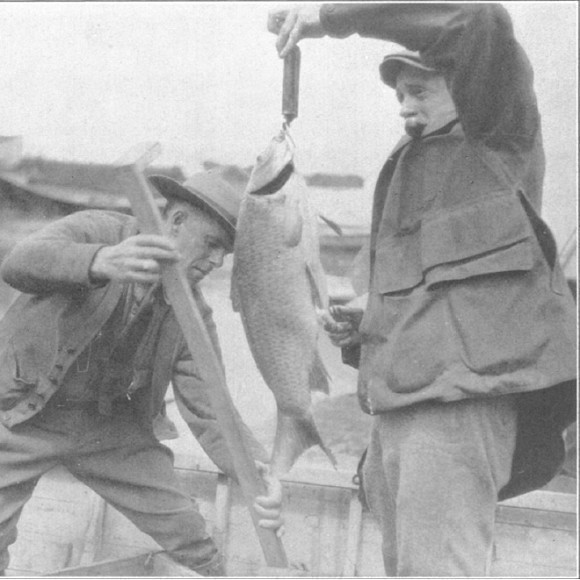
Carp were for commerce so handling, as in this image from the 1920s, was a bit more ‘robust’ than we are used to.
Now, as many of you will be aware, Americans have a fairly ambivalent attitude to carp. This would be immediately apparent to any English angler needing to stock up on carp tackle while over here. Visit any major tackle shop and you’ll find the walls filled with short rods and a huge array of lures, jigs and spinners. This tackle reflects the No. 1 desire of American fishermen - the largemouth bass. Trouble is bass don’t dig a vegan diet, don’t respond to pre-baiting, don’t move to preferred feeding areas. No, they sit and wait, pouncing on their prey from favoured ambush sites. The American anglers’ way with bass is to search for these ambush points from their high-tech bass boat. Bass boats are hideously over-engined machines that speed through the water sending up a wake that drowns quiet, contemplative bankside anglers. One thing bass anglers never are is still. Though that might be a criticism from a carp angler’s perspective it would be fair to add that American anglers have probably forgotten more about lure fishing than the English have ever known.
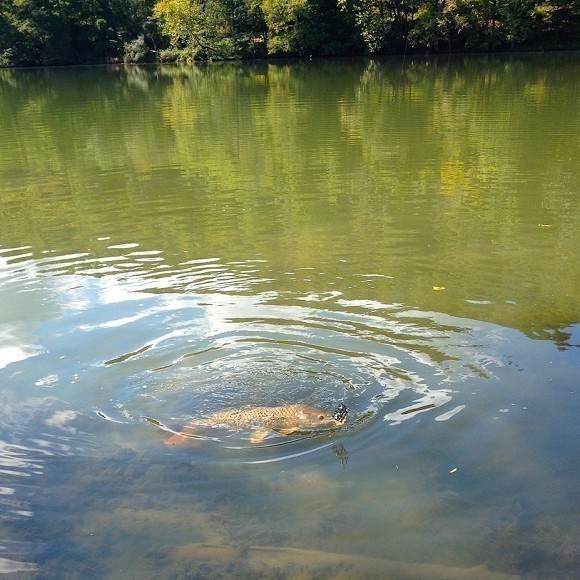
A double coming to the net from our local river. Note the homemade feeder, indicative of the paucity of good carp tackle here.
Despite all this there are small sections in the tackle shops devoted to the kind of kit carp fishermen would recognise. Packets of hooks, leads, swivels, some beads, a few floats. But they are uniformly awful. The hooks monstrous and blunt, the leads look as though they emerged from the first attempt your three year old made when given a mould-your-own kit containing lead ingots, a bit of flexible wire and a vast Bunsen burner. They even call floats ‘bobbers’ which says much about their attitude towards any fish for which they have to sit still and use bait. There is an angling population who use this kit. They fish for catfish. Catfish can grow large but on average a ‘nice’ channel cat will be about five pounds. The big difference between carp fishing and angling for catfish is that here the latter are eaten - they don’t often get a second chance to learn about baits and rigs because they end up in the pot. And even if some are released there is simply not the same level of pressure on them as occurs in the European carp scene. So little need for cunning bait or rig development.
There is one group that does hold carp dear though. Bow hunters. They tend to target carp in the spring when they come together in the shallows to spawn. We have run into some bow hunters already. They were steel-jawed men with grim dispositions, lukewarm I.Q.s and impressive girths who carefully scanned the water for any sign of a carp right over the swims we were fishing. Andy had to be physically restrained from ‘accidentally’ overcasting a three ounce lead into their midst. Encountering bow hunters is an unfortunate reality of fishing for carp here and we’ll undoubtedly run into their like again in the coming months.
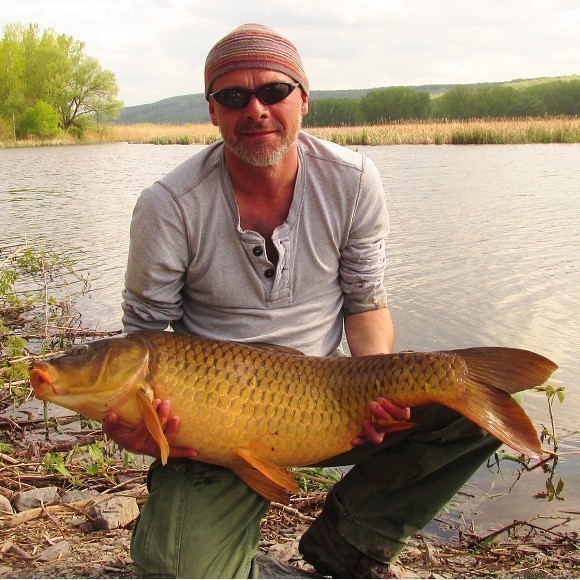
Andy with his thirty pound common from last year.
Now that might all sound rather negative. Fear not. Carp may be viewed as trash by many (though they are rapidly gaining a reputation among fly fishermen) but they are no longer persecuted (apart from those bow hunters). In fact carp were originally brought to the U.S. as part of a deliberate attempt to introduce and establish the species in American waters. Back in the 1870s the U.S. government saw them as the answer to the nations dwindling populations of native fish - a cheap, easy to rear and nutritious food source. So successful was the enterprise that they stopped production only twenty years after they started. By that time millions of pounds of fish were being harvested from major drainages like the Mississippi and Illinois rivers. Now carp are thought to be the most abundant inland fish in America yet they are also almost completely ignored by a population that loves to fish. To say that the carping potential of the U.S. is untapped would be as understated as saying the sun is quite warm, or that Andy is partial to the odd beer.
Most of the large fish on record were caught accidentally and though there is a carp fishing group in America (two actually - The American Carp Society and The Carp Anglers Group) they are too small to have made much of a splash with their captures or persuaded many Americans that carp are worth attention. The record for our local river, the upper reaches of which we started to fish last year, is 53lb. A visit to the Finger Lakes in New York State by a colleague produced a fish that took his 40lb scales to their limit with such a bump that he knew he had at least equaled Clarissa’s historic bulk. When we went to investigate the same lake Andy snaffled a beautiful thirty in the first full days fishing and while we didn’t catch another that size we went on to lasso some 300lb of fish in two days.
What is equally impressive is not just the size but also sheer quantity of carp in the various waters. They live where you would expect: the reservoirs, lakes, ponds and slow murky rivers. But they can also be found in deep, seemingly barren ribbon lakes formed when the ice sheet pushed down into the northern states many thousands of years ago. And they can be seen holding station in rivers nominally thought more suited to trout. Though numbers are not a problem what is less easy is identifying where the biggest ones lurk. Naturally we follow up previous reports of large carp (ironically some of this information comes from bow hunters) but the information’s accuracy can be hampered by the indifference Americans show to this fish. For example, our fisheries department regularly produces reports on what is in the State’s rivers and lakes. They record the number and size of fish caught by traps, electro-fishing and seining. But it is rare to find a report detailing carp. Often they are completely ignored even when caught. Occasionally they mention carp were present but only as an afterthought - a by-catch in the otherwise serious business of assessing the number of bass, or crappie, or even catfish.
So we have also turned to looking for casual references on forums devoted to other fish. On one site talk of a particular lake where “lunkers” and “huge hawgs” had been seen - genuine descriptions of large carp and not the usual jaded perversions to do with obese women and pigs - sounded promising. Following up the comments took us to lake where we watched huge commons heave their bulk out of the water at irregular intervals. Our limited attempts were thwarted in late summer by extensive weed growth restricting access to good-looking swims. We also managed to display our consummate carp catching skills to a group of curious locals by losing two of the three fish we hooked, the one landed (pictured above) obviously the smallest of the trio.
This lake is one we are certainly targeting as soon as the weather warms up. Then there are two other lakes we have just identified both with confirmed forty pounders. There’s also Andy’s favorite water, one where he has landed a big twenty among a hatful of other fish while at the same time trying to avoid the attentions of a corn-loving bear. There is the other lake that is full of carp and Simon thinks must hold a few large ones. Somewhere. Andy disagrees. And we shouldn’t forget the rivers too. We will have to visit the one the State record came from (it’s less than an hour away) and there’s the other much larger river that winds and ambles all across the State. It too holds very large carp.
All in all this is going to be another summer of dedicated carping and before the ice locks it all away again we’ll tell you all about it in our monthly “Carp Letter from America”.


